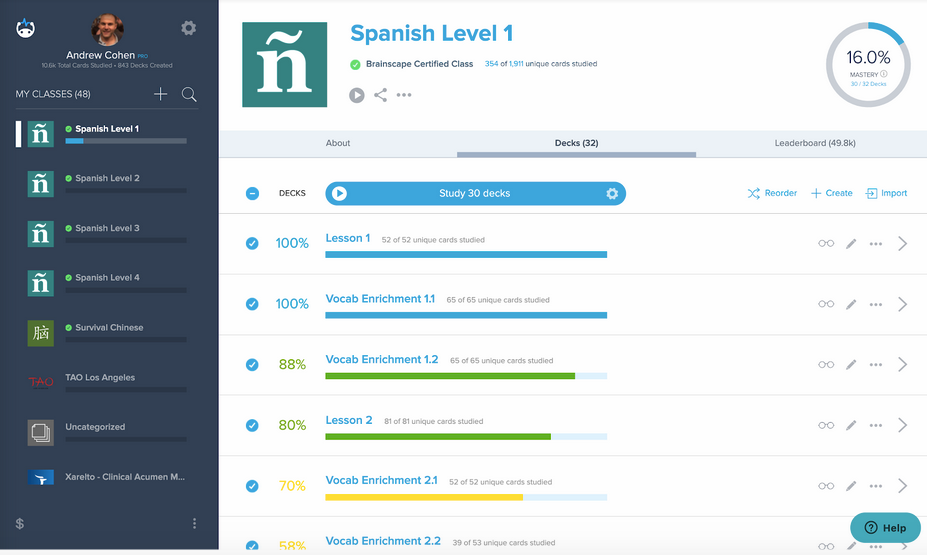This is one of the most popular questions we're asked. If you're thinking about learning a new language, you might be wondering just how much time and effort it will take. Will you need to dedicate years to the task, or is it possible to achieve fluency in a shorter timeframe?
Foreign languages are a popular learning interest (and necessity) for countless people around the world. The past century has witnessed an unprecedented surge in travel, international business, digital connectedness, and an accompanying blurring of country borders.
This is why Brainscape has developed the most effective spaced repetition algorithm for learning a language, combined with the world's first complete language curriculum written specifically for spaced repetition, as well as a complete set of online resources for learning any language on your own.
In the course of our research, we've found one particular question asked over and over again by many new language learners: how long should it take to learn a language? And so we put together this comprehensive answer!
This is how long it will take to learn a language
The (unsatisfactory) answer is it depends on three main factors:
1. The attitude of the learner
Are you disciplined or do you find it hard to concentrate? Are you learning a language more accessible to you, like Spanish (provided you're English-speaking) or less accessible, like Chinese? The attitude you adopt can make a huge difference to how fast you learn the language.
[Check out: 'Should you learn a foreign language? Maybe not (and that’s ok)'
2. The time available
How many hours per day can you spare for language practice? Will you even be studying every day? Or a few times per week? Or only when you visit your extended family in Mexico City? Naturally, the more often you practice, and the smarter your study methods, the faster your language learning will go.
3. The learner’s attentiveness to the language
How attentive we are to a language and how much we notice the finer details, greatly influences our learning. Many people aren't equipped to be naturally attentive, so they develop methods or find tools to help them cultivate attentiveness.

The best way to learn a language faster
Brainscape's a web and mobile flashcard app is one of the best tools for learning a foreign language. Our algorithm is engineered to leverage key cognitive science principles like spaced repetition, active recall, and metacognition. Brainscape breaks down a language into bite-sized flashcards of vocabulary, verb conjugations, and phrases, and drills you on them incrementally, one new concept at a time. This allows you to really ingrain the building blocks of the language, rather than just struggle through thousands of new words and concepts that you forget after completing each lesson or "game" in other apps.
If you're an even more motivated self-teaching type, we've put together a toolkit for you to learn a foreign language on your own, detailing various methods and tips. If you pick the right tools, you can double your language learning speed.
What is the hardest language to learn?
Okay, so what if we assume a positive attitude on the part of the learner and a reasonable and growing attentiveness to the language, and even a method that cultivates the learner’s attentiveness, how much time would it take then?
Because the time it takes to learn does not only depend on the learner. It also matters which language you're learning. FSI, the US Foreign Service Institute divides languages into groups of difficulty for speakers of English:
- Category I: Danish, Dutch, French, Italian, Norwegian, Portuguese, Romanian, Spanish, and Swedish. These are the easiest languages for English speakers to learn because they are the most similar to English. They also therefore take the least amount of time. The FSI estimates that it will take about 24-30 weeks or 600-750 class hours to become proficient in these languages.
- Category II: German, Hatian Creole, Indonesian, Malay, and Swahili. The FSI estimates these will take about 36 weeks or 900 class hours to become proficient.
- Category III: Azerbaijani, Bulgarian, Czech, Farsi, Finnish, Greek, Hebrew, Hindi, Polish, Russian, Somali, Tagalog, Tamil, Turkish, Thai, Ukranian, Urdu, and Vienamese. Languages in this category are have significant linguistic and cultural differences from English and so are harder to learn. The FSI estimates about 44 weeks or 1,100 class hours to become proficient.
- Category IV: Arabic, Chinese, Japanese, and Korean. The FSI says these are the most difficult languages for English-speakers to learn. They estimate 88 weeks or 2,200 class hours to proficiency.
Levels of proficiency matter
The time it takes to learn a language will also largely depend on your goal. Are you wanting to become fluent? Or just good enough for your next trip to Valencia? The FSI has also outlined 5 levels of proficiency:
- Level 0: No working proficiency. This person has very little working knowledge of the language. If you only know "Hola!" and "Una cerveza, por favor!", this is you.
- Level 1: Elementary proficiency. The person is able to satisfy routine travel needs and minimum courtesy requirements.
- Level 2: Limited working proficiency. The person is able to satisfy routine social demands and limited work requirements.
- Level 3: Professional working proficiency. The person can speak the language with sufficient structural accuracy and vocabulary to participate effectively in most formal and informal conversations on practical, social, and professional topics.
- Level 4: Full professional proficiency. The person uses the language fluently and accurately on all levels normally pertinent to professional needs.
- Level 5: Native or bilingual proficiency. The person has speaking proficiency equivalent to that of an educated native speaker.
On this scale, I would call 2 above basic conversational fluency. The time estimates presented earlier are the FSI's estimates for individuals to reach a level 3 (professional working proficiency on this scale). Typically, it will take more and more hours to get to higher and higher levels.
How long will it take me to learn a language?
Again, it depends on you, your goals, and the language. But if you are able to put in 10 hours a day, then elementary proficiency in the easy languages should take 48 days, and for difficult languages 72 days. Accounting for days off, this equates to two months or three months time. If you only put in 5 hours a day, it will take twice as long.
Are ten hours a day reasonable? It could be. Here is a sample day:
- 8 am - 12 pm: Alternate listening, reading and vocabulary review using Brainscape’s foreign language flashcards.
- 12 pm - 2 pm: Rest, exercise, lunch, while listening to the language.
- 2 pm - 3 pm: Grammar review
- 3 pm - 4 pm: Write
- 4 pm - 5 pm: Talk via Skype or with locals if in the country
- 5 pm - 7 pm: Rest
- 7 pm - 10 pm: Relaxation in the language, movies, songs, or going out with friends in the language, depending on availability.
- 10pm: A few study rounds in Brainscape before bed
This list is of course for a dedicated language learner on a mission. For most of us, 10 hours a day is way too much. But the good news is that even with 1 hour a day, you would be able to ready a good level of proficiency within a year.
Find the right motivation
Seeing the end of the finish line can be a major advantage. If you don't have a clear goal or a clear expectation of how long it can take for you to learn a language, it will be easy to lose motivation.
Take some time to analyze what kind of learner you are, think about the methods and tools that best suit your learning style, and choose your goal (level of proficiency). For some people, a language will need time to gestate and may not click in for months. For others, language learning will move a lot quicker and more intensely.

If you're looking for great motivation hacks to help you on your language learning journey, check out our guide on finding the motivation to study when you want to procrastinate!
When you combine a good routine with great motivation and a regular use of Brainscape’s web and mobile flashcards for an hour or more a day, you can achieve proficiency within a couple of months!
References
International Center for Language Studies, Inc. (2024). ILR Proficiency Levels. The International Center for Language Studies. https://www.icls.edu/government-language-training/ilr-proficiency-levels
International Center for Language Studies, Inc. (2024, August 2). How long does it take to learn a language? International Center for Language Studies. https://www.icls.edu/blog/how-long-does-it-take-to-learn-a-language
Kovac, M. M., & Mrsic, A. (2017). Students’Attitudes towards Foreign Languages. Journal of Educational and Developmental Psychology, 7(2), 124. https://doi.org/10.5539/jedp.v7n2p124
Lewis, R. (2020, July 31). Superpowers of effective English learners. Leonardo English. https://www.leonardoenglish.com/blog/english-superpowers
Lewis, R. (2022, October 16). How to become fluent in another language — in just one year | Better humans. Medium. https://betterhumans.pub/how-you-can-become-fluent-in-a-language-in-just-one-year-71ab80c5307c
United States Department of State. (2024, February 15). Foreign Language Training. https://www.state.gov/foreign-language-training/
